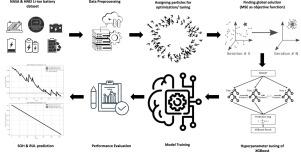Battery-Insight-PSO: A machine learning model for accurate prediction of state of health and remaining useful life in lithium-ion batteries
引用次数: 0
Abstract
Condition based monitoring (CBM) of the lithium-ion (Li-ion) battery has become very popular in recent years because of its wide usage as an energy storage for smart grids, power sources in various industrial equipment, electric vehicles (EVs), etc. As a result, predicting the state of health (SOH) and the remaining useful life (RUL) of Li-ion batteries with high accuracy ensures optimal performance and safe utilization, preventing non-scheduled failures and saving maintenance costs. This paper illustrates the significance of highly accurate SOH and RUL prediction for Li-ion batteries. This paper proposes a model called Battery-Insight-PSO, which employs the Extreme Gradient Boosting Regression (XGBoost) machine learning algorithm to forecast SOH and RUL. In this study, the Particle Swarm Optimization Algorithm (PSO) is used to optimize different parameters of XGBoost for ensuring precise and reliable predictions of SOH and RUL for Li-ion batteries. In this study, the National Aeronautics and Space Administration (NASA) Li-ion Battery Aging Datasets and the NMC LCO 18650 battery dataset from the Hawaii Natural Energy Institute (HNEI) were analyzed. Additionally, the performance of Battery-Insight-PSO was compared with other machine learning algorithms. Machine learning models were evaluated using various performance metrics. The estimation errors of Battery-Insight-PSO are very low, which means that this model can be highly accurate in predicting SOH and RUL. Moreover, the R scores for the training and testing sets of this model also show high consistency with 0.9998 for each dataset, demonstrating high accuracy and reliable performance.

Battery-Insight-PSO:用于准确预测锂离子电池健康状态和剩余使用寿命的机器学习模型
锂离子(Li-ion)电池的状态监测(CBM)近年来变得非常流行,因为它被广泛用于智能电网的储能、各种工业设备的电源、电动汽车(ev)等。因此,对锂离子电池的健康状态(SOH)和剩余使用寿命(RUL)进行高精度预测,可确保电池的最佳性能和安全使用,防止计划外故障,节省维护成本。本文阐述了对锂离子电池进行高精度SOH和RUL预测的意义。本文提出了一个名为Battery-Insight-PSO的模型,该模型采用极端梯度增强回归(XGBoost)机器学习算法来预测SOH和RUL。本研究采用粒子群优化算法(Particle Swarm Optimization Algorithm, PSO)对XGBoost的不同参数进行优化,以确保精确可靠地预测锂离子电池的SOH和RUL。在本研究中,分析了美国国家航空航天局(NASA)锂离子电池老化数据集和夏威夷自然能源研究所(HNEI)的NMC LCO 18650电池数据集。此外,还将Battery-Insight-PSO算法的性能与其他机器学习算法进行了比较。机器学习模型使用各种性能指标进行评估。电池- insight - pso的估计误差非常低,这意味着该模型可以非常准确地预测SOH和RUL。此外,该模型的训练集和测试集的R2分数也具有较高的一致性,每个数据集的R2分数均为0.9998,具有较高的准确性和可靠的性能。
本文章由计算机程序翻译,如有差异,请以英文原文为准。
求助全文
约1分钟内获得全文
求助全文

 求助内容:
求助内容: 应助结果提醒方式:
应助结果提醒方式:


